Opel Zafira 2014 Owner's Manual
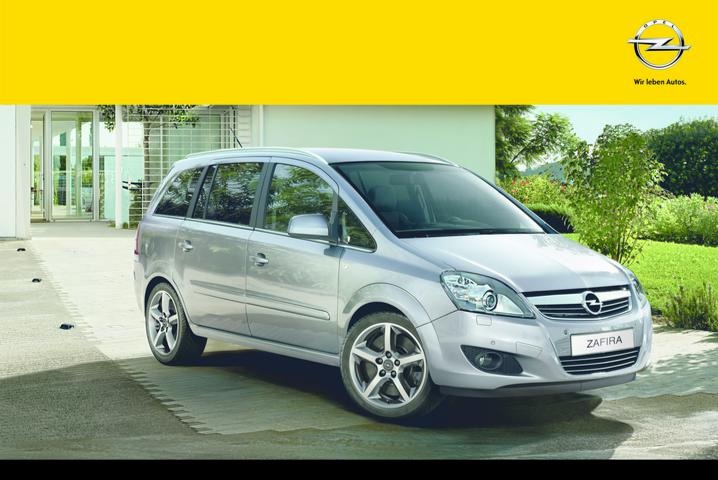
OPEL ZAFIRA
Owner's Manual

Contents
Introduction .................................... |
2 |
In brief ............................................ |
6 |
Keys, doors and windows ............ |
27 |
Seats, restraints ........................... |
44 |
Storage ........................................ |
69 |
Instruments and controls ............. |
79 |
Lighting ...................................... |
111 |
Climate control ........................... |
119 |
Driving and operating ................. |
127 |
Vehicle care ............................... |
155 |
Service and maintenance .......... |
196 |
Technical data ........................... |
200 |
Customer information ................ |
213 |
Index .......................................... |
216 |
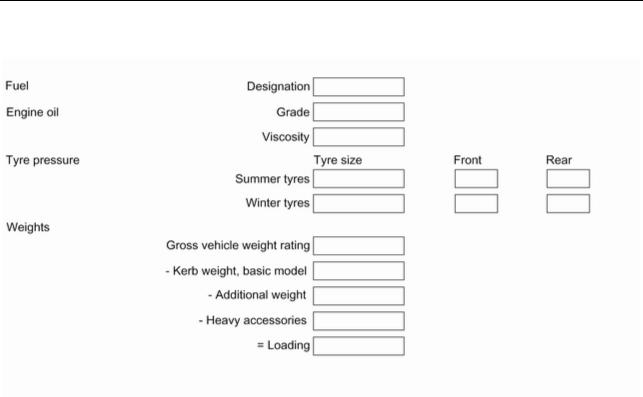
2Introduction
Introduction

Introduction 3
Vehicle specific data
Please enter your vehicle’s data on the previous page to keep it easily accessible. This information is available under the sections "Service and Maintenance" and "Technical data" as well as on the identification plate.
Introduction
Your vehicle is a designed combination of advanced technology, safety, environmental friendliness and economy.
This Owner’s Manual provides you with all the necessary information to enable you to drive your vehicle safely and efficiently.
Make sure your passengers are aware of the possible risk of accident and injury which may result from improper use of the vehicle.
You must always comply with the specific laws and regulations of the country that you are in. These laws may differ from the information in this Owner’s Manual.
WhenthisOwner’sManualreferstoa workshop visit, we recommend your Opel Service Partner.
All Opel Service Partners provide first-class service at reasonable prices. Experienced mechanics trained by Opel work according to specific Opel instructions.
The customer literature pack should always be kept ready to hand in the vehicle glovebox.
Using this manual
■This manual describes all options and features available for this model. Certain descriptions, including those for display and menu functions, may not apply to your vehicle due to model variant, country specifications, special equipment or accessories.
■The "In brief" section will give you an initial overview.
■The table of contents at the beginning of this manual and within each section shows where the information is located.
■The index will enable you to search for specific information.
■Yellow arrows in the illustrations serve as points of reference or indicate some action to be performed.
■Black arrows in the illustrations indicate a reaction or a second action to be performed.
■This Owner's Manual depicts lefthand drive vehicles. Operation is similarforright-handdrivevehicles.
■The Owner's Manual uses the factory engine designations. The corresponding sales designations can be found in the section "Technical data".
■Directional data, e.g. left or right, or front or back, always relate to the direction of travel.
■The vehicle display screens may not support your specific language.
■Display messages and interior labelling are written in bold letters.

4Introduction
Danger, Warnings and
Cautions
9 Danger
Text marked 9 Danger provides information on risk of fatal injury. Disregarding this information may endanger life.
9 Warning
Text marked 9 Warning provides information on risk of accident or injury. Disregarding this information may lead to injury.
Caution
Text marked Caution provides informationonpossibledamageto the vehicle. Disregarding this information may lead to vehicle damage.
Symbols
Page references are indicated with 3. 3 means "see page".
We wish you many hours of pleasurable driving.
Adam Opel AG

Introduction 5

6In brief
In brief |
Vehicle unlocking |
|
Radio remote control |
Initial drive information
Press button q to unlock and open
door. To open the tailgate, press the button under the moulding.
Radio remote control 3 28, Central locking system 3 32, Load compartment 3 35.
Electronic key
When in possession of the electronic key, simply pulling the door handle will unlock the vehicle and open the door. To open the tailgate, press the button under the moulding.
Open&Start system 3 29.
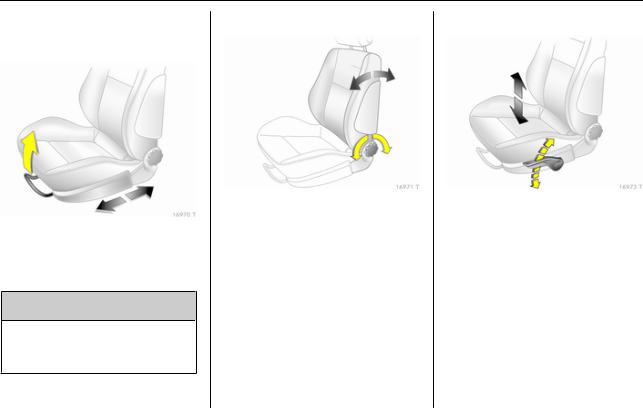
In brief |
7 |
Seat adjustment
Seat positioning
Pull handle, slide seat, release handle.
Seat adjustment 3 46, Seat position 3 46.
9 Danger
Do not sit nearer than 25 cm from the steering wheel, to permit safe airbag deployment.
Seat backrests
Turn handwheel. Do not lean on seat when adjusting.
Seat adjustment 3 46, Seat position 3 46, Folding front passenger seat backrest 3 49.
Seat height
Lever pumping motion
up |
= |
higher |
down |
= |
lower |
Seat adjustment 3 46, Seat position 3 46.
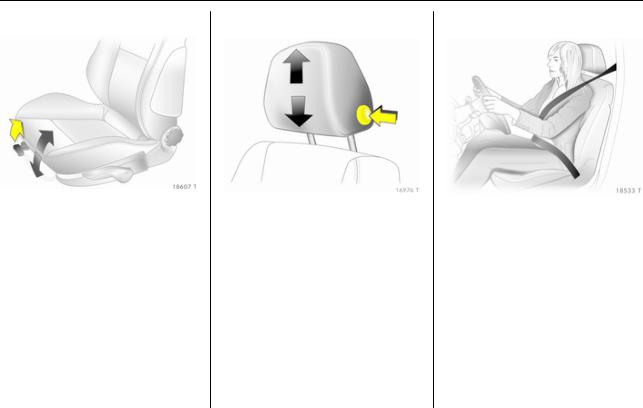
8In brief
Seat inclination
Pull lever, adjust inclination by shifting body weight. Release lever and audibly engage seat in position.
Seat adjustment 3 46, Seat position 3 46.
Head restraint adjustment |
Seat belt |
Press release button, adjust height, |
Pull out the seat belt and engage in |
engage. |
belt buckle. The seat belt must not be |
Head restraints 3 44. |
twisted and must fit close against the |
|
body. The backrest must not be tilted |
|
back too far (maximum approx. 25 °). |
|
To release belt, press red button on |
|
belt buckle. |
|
Seat belts 3 54, Airbag system |
|
3 58, Seat position 3 46. |
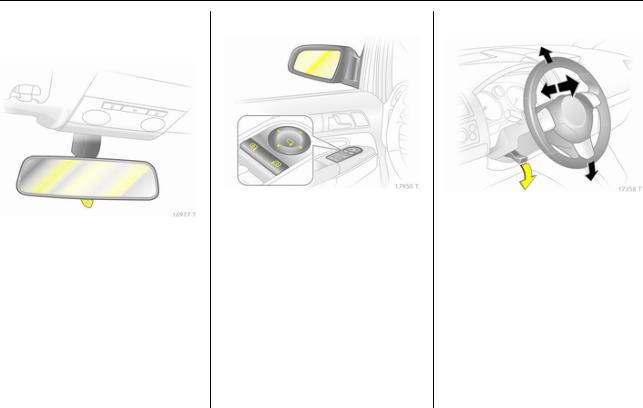
In brief |
9 |
Mirror adjustment
Interior mirror adjustment
Swivel the lever on the underside to reduce dazzle.
Interior mirror 3 40, Automatic antidazzle interior mirror 3 40.
Exterior mirrors adjustment
Selecttherelevantexteriormirrorand adjust.
Electric adjustment 3 38, Convex exterior mirrors 3 38, Folding exterior mirrors 3 39, Heated exterior mirrors 3 39.
Steering wheel adjustment
Unlock lever, adjust steering wheel, then engage lever and ensure it is fully locked. Do not adjust steering wheelunlessvehicleisstationaryand steering wheel lock has been released.
Airbag system 3 58, Ignition positions 3 128
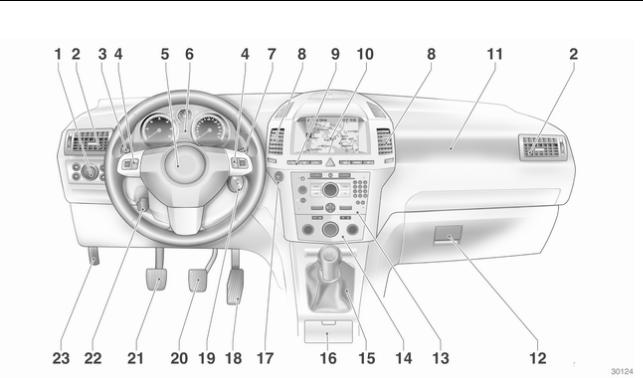
10 |
In brief |
Instrument panel overview

In brief |
11 |
1 |
Light switch ........................ |
111 |
|
Instrument illumination ....... |
116 |
|
Rear fog light ....................... |
115 |
|
Front fog lights ................... |
114 |
|
Headlight range |
|
|
adjustment ......................... |
112 |
2 |
Side air vents ...................... |
125 |
3Turn and lane-change signals, headlight flash,
low beam and high beam ... 114
|
Exit lighting .......................... |
117 |
|
Parking lights ...................... |
115 |
|
Cruise control ....................... |
95 |
4 |
Steering wheel controls ........ |
79 |
5 |
Horn ...................................... |
80 |
|
Driver airbag ......................... |
61 |
6 |
Instruments .......................... |
85 |
7Windscreen wiper, windscreen washer system, headlight washer
system .................................. |
80 |
8 Centre air vents ................... |
125 |
9
|
Hazard warning flashers |
114 |
|
Automatic transmission ....... |
131 |
|
16 |
Ashtray |
84 |
||
|
Central locking system |
32 |
|||
|
17 |
Start/Stop button |
29 |
||
|
Sport mode |
92 |
|||
|
18 |
Accelerator pedal ................ |
127 |
||
|
Right heated seat .................. |
49 |
19 |
Ignition switch with |
128 |
|
Fuel selector |
87 |
|
steering wheel lock ............. |
|
|
|
Sensor panel for |
|
||
10 |
Info-Display |
96 |
|
|
|
|
emergency operation of |
|
|||
|
|
|
|
|
|
|
Trip computer ...................... |
105 |
|
the Open&Start system ........ |
29 |
|
Electronic climate control |
|
20 |
Brake pedal ......................... |
141 |
|
|
21 |
Clutch pedal |
127 |
|
|
system ................................. |
122 |
|||
11 |
Front passenger airbag ......... |
61 |
22 |
Steering wheel adjustment ... |
79 |
12 |
Glovebox .............................. |
69 |
23 |
Bonnet release lever ........... |
157 |
13 |
Infotainment system .............. |
10 |
|
|
|
14 |
Climate control system ........ |
119 |
|
|
|
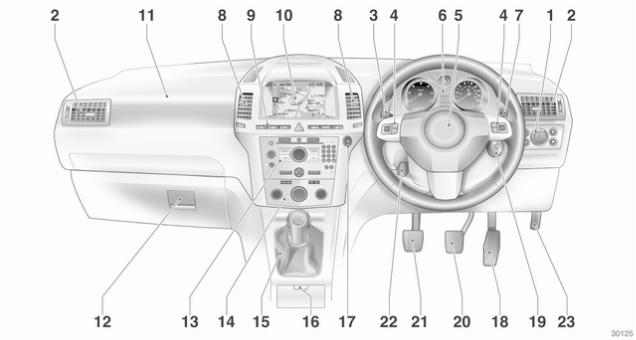
12 |
In brief |
|
|

In brief |
13 |
Exterior lighting
Turn light switch
7= Off
8 = sidelights
9= low beam
AUTO = Automatic light control
Press light switch
> = Front fog lights r = Rear fog light
Lighting 3 111, Headlight warning device 3 103.
Headlight flash, high beam and low beam
Headlight flash |
= |
Pull lever |
High beam |
= |
Push lever |
Low beam |
= Push or pull lever |
|
High beam 3 112, Headlight flash 3 112.
Turn and lane-change signals
To the right |
= |
Lever up |
To the left |
= |
Lever down |
Turn and lane-change signals 3 114.
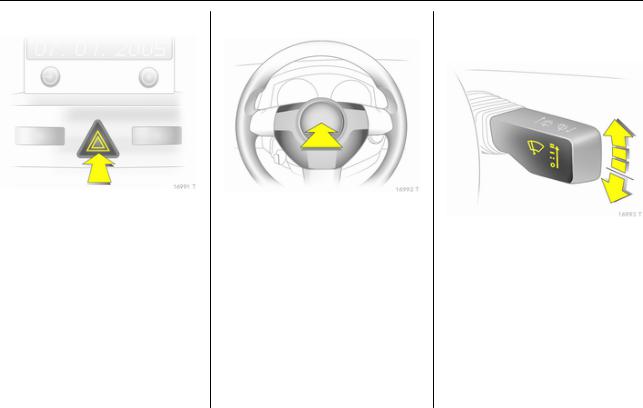
14 In brief
Hazard warning flashers |
Horn |
Washerandwipersystems |
|
|
Windscreen wiper |
Operated with the ¨button. |
Press j. |
|
|
Hazard warning flashers 3 114. |
& |
= |
fast |
|
|||
|
% = |
slow |
|
|
$ = |
timed interval wipe or |
|
|
|
|
automatic wiping with rain |
|
|
|
sensor |
|
§ |
= |
off |
|
For a single swipe when the |
||
|
windscreen wiper is off, press the |
||
|
lever down. |
||
|
Windscreen wiper 3 80, Wiper |
||
|
blade replacement 3 161. |
||

In brief |
15 |
Windscreen and headlight washer systems
Pull lever.
Windscreen and headlight washer system 3 80, Washer fluid 3 159.
Rear window wiper and washer systems
Wipers on |
= |
push lever |
Wipers off |
= |
push lever again |
Wash |
= |
push lever and hold |
Rear window wipers and washer system 3 81, Wiper blade
replacement 3 161, Washer fluid 3 159.
Climate control
Heated rear window, heated exterior mirrors
Heating is operated by pressing the Übutton.
Heated rear window 3 43.
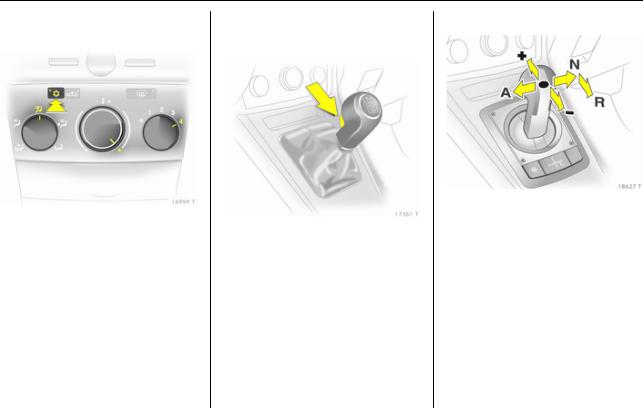
16 |
In brief |
Demisting and defrosting the windows
Air distribution to l.
Set temperature control to warmest level.
Set fan speed to highest level or to A.
Cooling non. Press button V.
Climate control system 3 119.
Transmission
Manual transmission
Reverse: with the vehicle stationary, wait 3 seconds after depressing clutch pedal and then press the release button on the selector lever and engage the gear.
If the gear does not engage, set the lever to neutral, release the clutch pedal and depress again; then repeat gear selection.
Manual transmission 3 136.
Manualtransmissionautomated
N = neutral position o = drive position + = higher gear
-= lower gear
A= switch between Automatic and Manual mode
R= reverse gear (with selector lever lock)
Manual transmission automated 3 137.
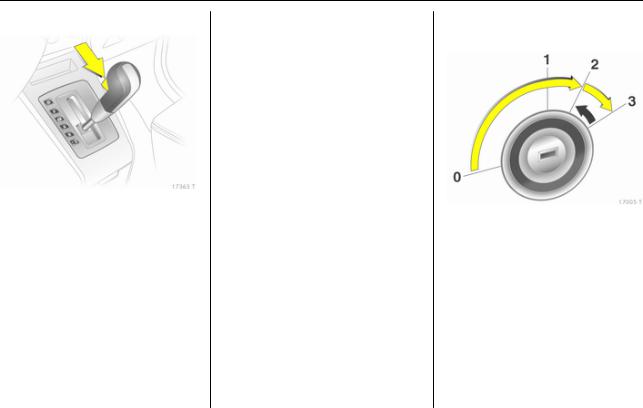
In brief |
17 |
Automatic transmission
P = park position R = reverse gear N = neutral position D = drive
The selector lever can only be moved out of P or N when the ignition is on and the foot brake is depressed (selector lever lock). To engage P or R, press the release button on selector lever.
The automatic transmission is available in two versions 3 131.
Starting off
Check before starting off
■Tyre pressure and condition 3 177, 3 211.
■Engine oil level and fluid levels 3 157.
■All windows, mirrors, exterior lighting and number plates are free from dirt, snow and ice and are operational.
■Proper position of seats, seat belts and mirrors 3 46, 3 55, 3 38.
■Brake function at low speed, particularly if the brakes are wet.
Starting engine with ignition switch
■Turn key to position 1
■Move the steering wheel slightly to release the steering wheel lock
■Operate clutch and brake, automatic transmission in P or N
■Do not operate the accelerator pedal
■Diesel engines, turn the key to position 2 for preheating and wait until control indicator !goes out
■Turnkeyto3andreleasekeywhen engine is running.
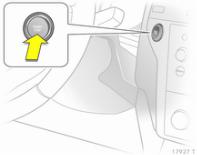
18 |
In brief |
|
|
|
|
|
|
|
|
|
|
Starting engine with Start/Stop |
|
Open&Start system 3 29. |
|
Parking |
|
|
|
||||
button |
|
|
|
|
■ Always apply the parking brake |
|
|
|
|
|
withoutpressingthereleasebutton. |
|
|
|
|
|
Apply as firmly as possible on a |
|
|
|
|
|
downhill slope or uphill slope. |
|
|
|
|
|
Depress the foot brake at the same |
|
|
|
|
|
time to reduce operating force. |
|
|
|
|
|
■ Switch off the engine. Turn the |
|
|
|
|
|
ignition key to 0 and remove it or, |
|
|
|
|
|
with the vehicle stationary, press |
|
|
|
|
|
the Start/Stop button and open the |
|
|
|
|
|
driver's door. Turn the steering |
|
|
|
|
|
wheel until the steering wheel lock |
|
|
|
|
|
is felt to engage. |
The electronic key must be inside the |
|
|
|
For vehicles with automatic |
|
vehicle. |
|
|
|
|
transmission, the key can only be |
■ Operate clutch and brake, |
|
|
|
removed when the selector lever is |
|
automatic transmission in P or N |
|
|
|
inthePposition.IfPisnotengaged |
|
■ Do not operate the accelerator |
|
|
|
or the parking brake is not applied, |
|
|
|
|
"P" flashes for a few seconds in the |
||
pedal |
|
|
|
|
|
|
|
|
|
transmission display. |
|
■ Diesel engine, press the button |
|
|
|
||
|
|
|
■ Ifthevehicleisonalevelsurfaceor |
||
briefly to start preheating, move the |
|
|
|
||
|
|
|
uphillslope,engagefirstgearorset |
||
steering wheel slightly to release |
|
|
|
||
|
|
|
the selector lever to P before |
||
the steering wheel lock, wait until |
|
|
|
||
|
|
|
switching off the ignition. On an |
||
control indicator !goes out |
|
|
|
||
|
|
|
uphill slope, turn the front wheels |
||
■ Press button for 1 second and |
|
|
|
||
|
|
|
away from the kerb. |
||
releasewhentheengineisrunning. |
|
|
|
|
|

In brief |
19 |
If the vehicle is on a downhill slope, engage reverse gear or set the selector lever to P before switching off the ignition. Turn the front wheels towards the kerb.
■Lock the vehicle with button p on the radio remote control or with the sensor in a front door handle.
To activate the anti-theft locking system and the anti-theft alarm system, press button p twice or touch the sensor in a front door handle twice.
■Donotparkthevehicleonaneasily ignitable surface. The high temperature of the exhaust system could ignite the surface.
■On vehicles with manual transmission automated, control indicator Rflashes for a few seconds after the ignition is switchedoffiftheparkingbrakehas not been applied 3 103.
■Close windows.
■The engine cooling fans may run after the engine has been switched off 3 156.
■Afterrunningathighenginespeeds or with high engine loads, operate the engine briefly at a low load or run in neutral for approx.
30 seconds before switching off, in order to protect the turbocharger.
Keys, locking 3 27, Laying the
vehicle up for a long period of time 3 155.

20 |
In brief |
Notable features |
Seats in second row |
9 Warning
When the row of seats or the backrests are being adjusted, keep hands away from the hinge area.
Moving seats
Push the release lever forward and slide the seat row. Release the lever and audibly engage the seats.
Adjust backrests of outboard seats
Push the release lever down, adjust inclination, release the lever and engage the backrest.
9 Warning
Occupants may only travel on a seat if its backrest is properly engaged in the upright position.

In brief |
21 |
Seats in third row
9 Warning
When the seats are being moved upright or folded in, keep hands away from hinge area.
Setting up seats
Remove floor covering 3 72 and load compartment cover 3 71.
Push the lever forward and slide the second row of seats forward to the mark.
Guide the seat belts through the belt holders and insert the latch plates in the holders.
9 Warning
On version with side rails in load compartment, follow the descriptions 3 73.
From the luggage compartment, pull up the seat by the handle.

22 |
In brief |
|
|
Swivel the seat rearward until it is uprightandaudiblyengages.Support thetopofthebackrestwithyourhand.
Preparing belt buckles for use 3 55, Load compartment cover
3 71.
9 Warning
The belt must not be routed through the belt holder when the seat belt is in use.
Slide the second row of seats to the required position and engage.
Storing seats
Remove the load compartment cover 3 71.
Push the lever forward and slide the second row of seats forward to the mark.
Press the catch to release and slide the head restraints of the third row all the way down.
Guide the seat belts through the belt holders and insert the latch plates in the holders.
From the luggage compartment, press the button on the top of the backrest and lower the backrest. Using the handle on the seat, pull rearwards and upwards and then swing the seat forwards until it is lowered into the vehicle floor. Hold the seat by the handle during the entire procedure.
Retract belt buckle 3 55 and install floor covering 3 72 and load compartment cover 3 71.
Slide the second row of seats to the required position and engage.
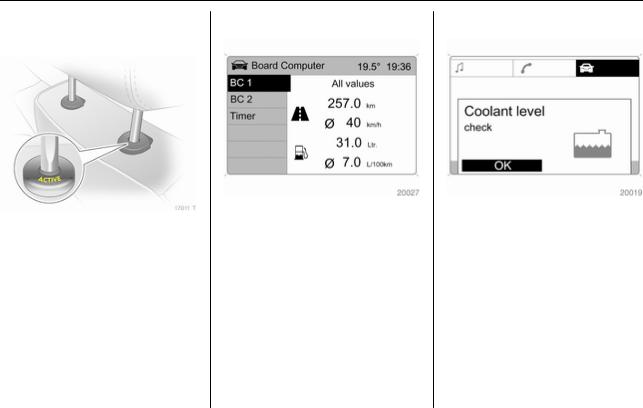
In brief |
23 |
Active head restraints on front seats
In the event of a rear-end impact, the active head restraints tilt forwards slightly. The head is more effectively supported by the head restraint and the risk of whiplash injury is reduced.
Active head restraints can be recognised by the word ACTIVE.
Head restraints 3 44.
Trip computer |
Check control |
Functions: |
The check control monitors: |
■ Range |
■ Fluid levels |
■ Instantaneous consumption |
■ Tyre pressure |
■ Distance |
■ Radio remote control battery |
■ Average speed |
■ Anti-theft alarm system |
■ Absolute consumption |
■ Important exterior lighting bulbs, |
■ Average consumption |
including cables and fuses. |
■ Stop watch |
Display messages 3 103. |
■ Tyre pressure |
|
Trip computer 3 105, 3 107. |
|

24 |
In brief |
Sport mode
Activate by pressing the SPORT button.
The Sport mode is used to make suspension and steering more direct. The engine is more responsive to throttle application. With manual transmission automated and automatic transmission, gear changing is altered.
Sport mode 3 143.
FlexOrganizer
The side walls contain retaining strips, where various components can be attached to divide the load compartment or fasten loads.
The system consists of
■adapters
■variable partition net
■mesh pockets for the side walls
■hooks in the load compartment FlexOrganizer 3 73.
Tyre pressure monitoring system
A pressure sensor is integrated in each wheel to monitor tyre pressure.
Low tyre pressure will be indicated with a yellow control indicator A. The current tyre pressure and warning messages may be displayed in the Info-display.
Tyre pressure monitoring system 3 93, 3 178.
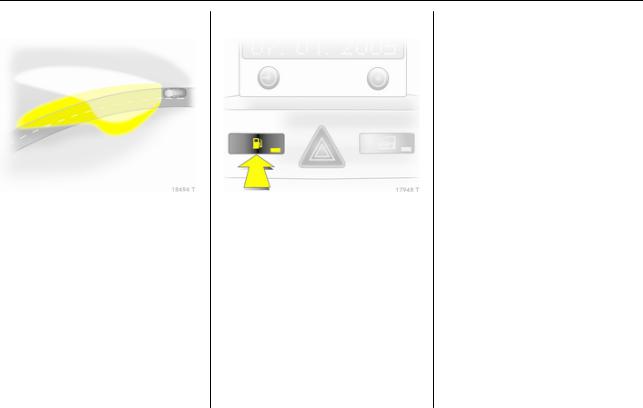
In brief |
25 |
Adaptive Forward Lighting |
Natural gas operation |
The system improves lighting of |
This specially developed engine is |
||
curves and increases the headlight |
designed for the use of natural gas |
||
range. |
and petrol. |
|
|
The beam pivots based on steering |
The Ybutton is used to switch |
||
wheel position and vehicle speed. |
between petrol and natural gas |
||
At higher speeds and continuous |
operation. |
|
|
straight ahead travel, the beam |
The status of the LED indicates the |
||
automatically raises slightly, thereby |
type of fuel in use. |
|
|
increasing headlight range. |
Natural gas |
= |
LED off. |
Adaptive Forward Lighting 3 113. |
operation |
|
|
|
Petrol operation |
= |
LED illuminates. |
|
Natural gas 3 87, 3 147. |
||
Diesel particle filter
The diesel particle filter system filters harmful soot particles out of the exhaust gases. The system includes a self-cleaning function that runs automatically during driving. The filter is cleaned by burning off the soot particles at high temperature. This process takes place automatically under set driving conditions and may take up to 25 minutes. Fuel consumption may be higher during this period. The emission of smells and smoke during this process is normal.

26 |
In brief |
|
|
Under certain driving conditions, e.g. short distances, the system cannot clean itself automatically.
If the filter requires cleaning and previous driving conditions did not enable automatic cleaning, control indicator !flashes.
Further instructions 3 130.

Keys, doors and windows |
27 |
Keys, doors and |
|
windows |
|
Keys, locks ................................... |
27 |
Doors ........................................... |
35 |
Vehicle security ............................ |
36 |
Exterior mirrors ............................ |
38 |
Interior mirrors ............................. |
40 |
Windows ...................................... |
40 |
Roof ............................................. |
43 |
Keys, locks
Keys
Replacement keys
The key number is specified in the Car Pass or on a detachable tag.
The key number must be quoted when ordering replacement keys as it is a component of the immobiliser system.
When electronic keys of the Open&Start system are being replaced, all keys requiring programmingmustbehandedoverto the dealer.
Locks 3 192, Open&Start system, electronic key 3 29.
Key with foldaway key section
Press button to extend. To fold the key, first press the button.
Car Pass
The Car Pass contains security related vehicle data and should therefore be kept in a safe place.
When the car is taken to a workshop, this vehicle data is needed in order to perform certain operations.
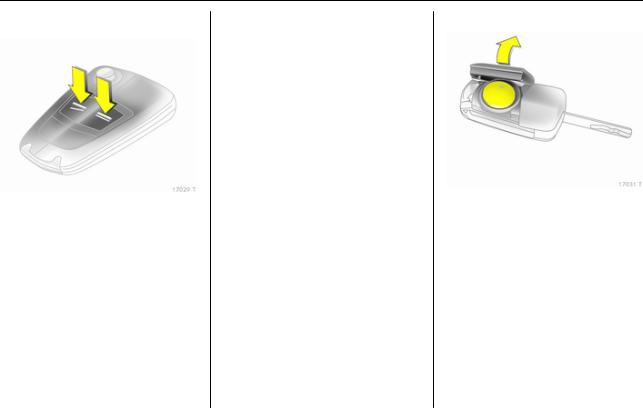
28 Keys, doors and windows
Radio remote control
Used to operate:
■Central locking system,
■Anti-theft locking system,
■Anti-theft alarm system,
■Power windows.
The radio remote control has a range of approx. 5 metres. This range can be affected by outside influences.
The hazard warning flashers confirm operation.
Handle with care, protect from moisture and high temperatures and avoid unnecessary operation.
Fault
If the central locking system cannot be operated with the radio remote control,itmaybeduetothefollowing:
■Range exceeded,
■Battery voltage too low,
■Frequent,repeatedoperationofthe radio remote control while not in range, which will require resynchronisation,
■Overload of the central locking system by operating at frequent intervals, the power supply is interrupted for a short time,
■Interference from higher-power radio waves from other sources.
Unlocking 3 32.
Radio remote control battery replacement
Replace the battery as soon as the range reduces.
Batteries do not belong in household waste. They must be disposed of at an appropriate recycling collection point.
Key with foldaway key section
Extend the key and open the unit. Replace the battery (battery type CR 2032), paying attention to the installation position. Close the unit and synchronise.
Key with fixed key section
Have the battery replaced by a workshop.
